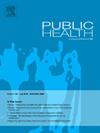Burden of hypertension, diabetes, and hypercholesterolemia in relation to social and behavioral health determinants: Insights from the 2018 Bangladesh STEPS survey
IF 3.9
3区 医学
Q1 PUBLIC, ENVIRONMENTAL & OCCUPATIONAL HEALTH
引用次数: 0
Abstract
Objectives
Bangladesh is experiencing a significant shift in its epidemiological landscape, moving from a predominance of communicable diseases to an increasing burden of non-communicable diseases (NCDs). This study aims to identify the risk factors for hypertension, diabetes, and hypercholesterolemia based on the recent STEPS survey in Bangladesh.
Study design
Secondary cross-sectional study.
Methods
This study analyze the publicly available “National STEPS Survey for Non-communicable Diseases Risk Factors in Bangladesh 2018” dataset. The sample size was 6875, after cleaning the three phases of dataset. Frequency distribution, Spatial distribution, Chi-square test, and Logistic regression models were employed in data analysis.
Results
The nationwide prevalence of NCDs revealed 27.3 % for hypertension, 9.8 % for diabetes, and 30.2 % for hypercholesterolemia. The NCDs prevalence significantly varied across divisions in Bangladesh, with Barisal having the highest hypertension (25 %) and Sylhet the lowest (18.1 %). Chittagong led in diabetes prevalence (12.0 %), while Rangpur had the lowest (4.8 %). For hypercholesterolemia, Barisal topped (34.9 %), and Mymensingh had the lowest (20.9 %). The significant risk factors of NCDs included age, occupational status, physical activity, and BMI category. Older age and obesity notably increased significantly (p < 0.05) the odds of hypertension, diabetes, and hypercholesterolemia, while urban residence increased the odds of diabetes.
Conclusion
Several factors, mostly age, occupational status, physical activity, and BMI category are responsible for higher prevalence of NCD diseases. The study explores common factors in NCDs and offers regional comparisons, aiding policymakers in focused interventions for specific regions.
高血压、糖尿病和高胆固醇血症负担与社会和行为健康决定因素的关系:来自2018年孟加拉国STEPS调查的见解
孟加拉国的流行病学状况正在发生重大转变,从传染病占主导地位转变为非传染性疾病负担日益沉重。本研究旨在根据孟加拉国最近的STEPS调查,确定高血压、糖尿病和高胆固醇血症的危险因素。研究设计二次横断面研究。方法本研究分析了公开的“2018年孟加拉国非传染性疾病风险因素国家STEPS调查”数据集。在清理了数据集的三个阶段后,样本量为6875。数据分析采用频率分布、空间分布、卡方检验和Logistic回归模型。结果全国非传染性疾病患病率为高血压27.3%,糖尿病9.8%,高胆固醇血症30.2%。孟加拉国各区的非传染性疾病患病率差异显著,Barisal的高血压患病率最高(25%),而Sylhet的高血压患病率最低(18.1%)。吉大港的糖尿病患病率最高(12.0%),而Rangpur最低(4.8%)。对于高胆固醇血症,Barisal最高(34.9%),Mymensingh最低(20.9%)。非传染性疾病的重要危险因素包括年龄、职业状况、身体活动和BMI类别。老年和肥胖显著增加(p <;0.05)高血压,糖尿病和高胆固醇血症的几率,而城市居住增加了糖尿病的几率。结论非传染性疾病的高发与年龄、职业状况、体力活动和BMI类别等因素有关。该研究探讨了非传染性疾病的共同因素,并提供了区域比较,帮助决策者针对特定地区采取重点干预措施。
本文章由计算机程序翻译,如有差异,请以英文原文为准。
求助全文
约1分钟内获得全文
求助全文
来源期刊

Public Health
医学-公共卫生、环境卫生与职业卫生
CiteScore
7.60
自引率
0.00%
发文量
280
审稿时长
37 days
期刊介绍:
Public Health is an international, multidisciplinary peer-reviewed journal. It publishes original papers, reviews and short reports on all aspects of the science, philosophy, and practice of public health.
 求助内容:
求助内容: 应助结果提醒方式:
应助结果提醒方式:


